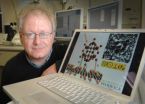(Press-News.org) New research published today in the journal Science says people think about things they think they don't think about. Vanderbilt University psychologists Gordon Logan and Matthew Crump say when highly skilled people such as surgeons, carpenters, or pilots perform actions without thinking, those actions are highly controlled. The finding adds key information to a debate on whether people consciously perform actions in which they are highly skilled.
Previous research suggests conscious control of driving a car for an experienced driver, for example, is an illusion. These studies point to cases in which people intend to do one thing but do another. But the Vanderbilt research, involving a simple typing test, shows otherwise.
"Our research shows a very tight coupling between intention and action that suggests conscious control is not an illusion," said Logan, Vanderbilt's Centennial Professor of Psychology. "In highly-skilled activities like typing, intention and action fit together very tightly."
The National Science Foundation funded the research, "Cognitive Illusions of Authorship Reveal Hierarchical Error Detection in Skilled Typists," through its Division of Behavioral and Cognitive Sciences in its directorate for social, behavioral and economic sciences.
Logan and Crump tested 72 college-age typists each of whom had about 12 years of typing experience and typed at speeds comparable to professional typists. In three experiments, these skilled typists typed single words shown to them one at a time on a computer screen and their responses appeared on the screen below the word to be typed.
The researchers then secretly introduced errors to see if the typists would detect them. In some instances, they secretly corrected errors made by the typists. In both cases, responses were gauged by measuring the speed at which words were typed.
Logan and Crump found the typists' fingers did not slow down after an error was secretly inserted even though the typists thought they made the error. But when typists made errors, their fingers slowed down whether researchers corrected those errors or not.
The researchers concluded this happens because there are two different processes that create and detect errors. "The 'outer loop' or thinking part of the process tries to decide whether the 'inner loop' or doing part of the process is right or wrong," said Logan.
He contends the 'inner loop' or doing part of the process looks at the hands, fingers and the feel of the keyboard to decide whether the action is correct.
"The illusion of authorship was the most surprising thing," said Logan. "People thought they typed correctly if the screen looked right and they thought they typed incorrectly if the screen looked wrong even though their fingers 'knew' the truth."
This "knowing of the truth" proves that skills people perform without thinking are highly controlled. Logan and Crump argue that control is hierarchical. That part of a person that does the thinking relies on different feedback than the part that does the doing. But the two kinds of feedback together allow people to consciously achieve tremendous degrees of precision and speed.
Logan and Crump dismiss an alternative possibility that there is only one process that detects errors. They contend that if there was only one process, then conscious reports should match what the fingers do.
Typists should have slow down whenever they reported an error and typed at full speed whenever they reported a correct response. Instead, the researchers discovered a mismatch between conscious reports and behavior, suggesting two error detection processes.
"What's cool about our research is that we show there are two error detection processes: an outer loop that supports conscious reports and an inner loop process that slows keystrokes after errors," said Logan. "Typing slows down after corrected errors just like it slows down after actual errors. It maintains the same speed after inserted errors as after correct responses, as if nothing was wrong."
These finger movements, according to project researchers, show people consciously control actions in which they are highly skilled even when they don't think about them.
INFORMATION: END
DETROIT – African Americans are more likely to have a recurrence of uterine cancer despite undergoing a total hysterectomy or a hysterectomy followed by radiation therapy, according to researchers at Henry Ford Hospital in Detroit.
"The African American patients in our study had similar surgeries and radiation therapy as the Caucasian patients in the study. So access to care certainly wasn't a factor in race being identified as a negative predictor for outcome," says lead author Mohamed Elshaikh, M.D., senior staff physician in the Department of Radiation Oncology at ...
The UK's National Physical Laboratory (NPL) has developed a new portable radiation detector that can assess the safety of potentially contaminated areas far quicker than current methods. The prototype was inspired by the aftermath of the murder of Alexander Litvinenko in London 2006.
Litvinenko's death was due to radiation poisoning from polonium-210. It prompted wide-scale work to assess radiation levels at almost 50 premises in London that he had been prior to his death before opening them up again to the public, costing the Health Protection Agency £2 million.
The ...
The single layer material Graphene was the subject of a Nobel prize this year but research led by a team of researchers at the University of Warwick has found molecular hooks on the surface of its close chemical cousin, Graphene Oxide, that will potentially provide massive benefits to researchers using transmission electron microscopes. They could even be used in building molecular scale mechanisms.
The research team, which includes Drs. Jeremy Sloan, Neil Wilson and PhD student Priyanka Pandey from the Department of Physics and Dr. Jon Rourke from the Department of Chemistry ...
Everybody knows that if you're physically fit, you're less likely to get a wide range of diseases. What most people don't know is that some people are "naturally" in better shape than others, and this variation in conditioning makes it difficult to test for disease risk and drug effectiveness in animal models. A new research paper published in the November 2010 print issue of The FASEB Journal (http://www.faseb.org) started out as a study to explain the strong statistical link between low aerobic exercise capacity and common diseases, but ultimately led to an animal model ...
When looking for new ways to treat aggressive brain cancers, an international team of scientists turned a new leaf and "discovered" the lowly daffodil. A new research study published in the November 2010 print issue of The FASEB Journal (http://www.fasebj.org) offers hope that a natural compound found in daffodil bulbs, called narciclasine, may be a powerful therapeutic against biologically aggressive forms of human brain cancers.
"We are planning to move a narciclasine derivative toward clinical trials in oncology within a three to four year period in order to help patients ...
Scientists are keeping their eye on a new discovery published in the November 2011 print issue of the FASEB Journal (http://www.fasebj.org) that explains what causes some genes to go out of control. Scientists have identified a "cellular switch," called eye transformer, that controls the flow of information from chemical signals outside of the cell to genes in the cell nucleus. This study demonstrates that when eye transformer is turned off, the information pathway it controls (the "JAK/STAT pathway") hyper-activates. Because this pathway exists in humans and is involved ...
ROCHESTER, Minn. -- Statistics from the Centers for Disease Control and Prevention (CDC) (http://www.cdc.gov/) rank mortality related to chronic liver disease and cirrhosis as the 12th most common cause of death in adults in the U.S. Using a modified definition that includes diseases such as viral hepatitis, liver cancer (http://www.mayoclinic.org/liver-cancer/) and obesity-related fatty liver disease (liver diseases)(http://www.mayoclinic.org/liver-disease/), Mayo Clinic-led researchers have found that liver-related mortality is as high as fourth for some age groups, and ...
Tampa, Fla. (Nov. 01, 2010) – When researchers tested three different labeling agents on three different stem cell populations to determine what effect the labeling agents had on stem cell phenotype, biological behavior and migration abilities, they found changes in stem cell proliferation depending on the type of contrast agent used.
The team of researchers from Belgium and Spain tested USPIO (ultra small superparamagnetic iron oxide) contrast agents Resovist ®, Endorem ® and Sinerem ® on mouse embryonic stem cells (mESC), rat multipotent adult progenitor cells (rMAPC) ...
While wind energy has shown strong potential as a large-scale, emission-free energy source, bat and bird collisions at wind turbines result in thousands of fatalities annually. Migratory bats, such as the hoary bat, are especially at risk for collision with wind turbines as they fly their routes in the forested ridges of the eastern U.S. This loss not only impacts the immediate area, but is also detrimental to ecosystem health nationwide—that is, bats help with pest management, pollination and the dispersal of numerous plant seeds.
Since turbine towers and non-spinning ...
With a lifelong interest in politics, University of Cincinnati researcher Muer Yang spent the last two years developing a quantitative method for allocating voting machines that could significantly reduce the average wait time of voters.
During the 2004 U.S. presidential elections, some voters waited in lines for more than 10 hours to cast their ballots, and in Ohio, the last vote was cast at 4 a.m., noted Ohio Secretary of State Jennifer Brunner in a public report. Ohio lines in the '06 and '08 elections were still so lengthy that they essentially "disenfranchised" voters ...

